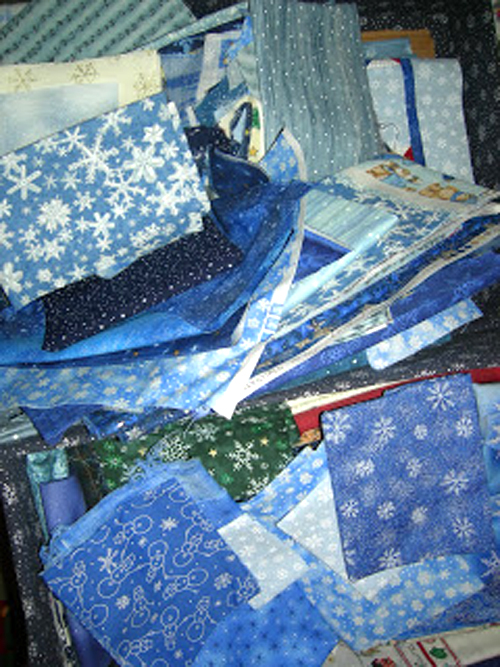42x54 For a larger quilt you can make additional blocks or add different borders to expand it.
There are 2 star blocks, 4 striped blocks, 2 cross blocks, 2 tower blocks and 2 butterfly blocks.
All except the butterfly blocks can be cut and assembled from simple strips and squares. The
butterfly block pattern is included for paper piecing. If you prefer to use conventional piecing,
copy the block diagrams and add 1/4 seam allowance around each finished size area.
Use red and red prints, blue or blue prints, white or white on white prints and gold/yellow as the
main colors. The towers can be of a wide variety of colors.
Cut eight pieces of red or red print 4 1/2 x 12 1/2. Hint: If you cut the strips 13 long and trim
the finished blocks, you won’t have to worry about getting each exactly lined up.
Cut four pieces 4 1/2 x 12 1/2 of white or white on white print.
For each block, sew red, white, red together along the long sides. Trim to 12 1/2 square.
Make four.
For the two Star Blocks:
Cut eight squares 4 1/2 x 4 1/2 of white or white on white print.
Cut four squares 4 1.2 x 4 1/2 of blue or blue print
Cut four squares 4 7/8 x 4 7/8 of white or white on white print and cut in half diagonally
Cut four squares 4 7/8 x 4 7/8 of blue or blue print and cut in half diagonally
Sew one triangle of white to one triangle of blue sewing along the diagonal using a scant 1/4:
seam allowance. Trim to 4 1/2 square. Repeat to make 8 total.
Assemble nine-patch as follows (refer to diagram for proper placement of the blue/white blocks):
Top row: white, blue/white, white.
Middle row: blue/white, blue. blue/white
Bottom row: white, blue/white, white
Make two nine patch star blocks.
For the Tower Blocks
Cut six pieces 2 1/2 x 12 1/2 of white or white on white. (note: you might want to start with
13 strips and trim them later).
Cut 74 pieces each 1 1/4 x 3 1/2 from multi-colored fabrics. We chose a variety of colors and
prints to symbolize the many different nationalities and ethnic groups affected by the tragedies of
September 11.
Sew 16 pieces together along the 3 1/2 side to make a strip 12 1/2 long. When selecting colors,
just make sure that the end colors are different on each, so your don’t get two floors of the
same color touching where the blocks meet. Repeat tower segments.
Sew the blocks together white, tower, white, tower, white, sewing along the long sides to form
blocks 12 1/2 square.
For the two Cross Blocks:
Cut eight pieces 6 1/2 x 3 1/2 of red or red print
Cut four pieces 6 1/2 x 2 1/2 of blue or blue print
Cut two pieces 6 1/2 x 2 1/2 of white or white on white
Cut four squares 3 7/8 x 3 7/8 of blue or blue print. Cut in half diagonally.
Cut four squares 3 7/8 x 3 7/8 of white or white on white. Cut in half diagonally.
Assemble as follows:
Part A
Stitch long red strip to long blue strip to white strip to blue strip to red strip.
Part B
Stitch one blue triangle to one white triangle using scant 1/4 seam, sewing along the diagonal.
Make four for each block (8 total)
Part C
Stitch one blue/white to the short end of one red strip. Stitch another blue/white to the other
short end of the red strip. (Check the diagram for proper placement of the blue/white squares
the goal is to put the blue in the outside corners of the block.)
Stitch one Part C vertically to the side of Part A. Refer to diagram.
Stitch one Part C vertically to the other side of Part A.
Make two of these blocks. You can use the center white section to write something a date,
your name, the name of someone or an organization you want to honor, a prayer. We recommend
using a Pigma Pen and pressing to heat set it. You may want to do the writing before you assemble the block, in case you want to change the written portion.
For the two butterfly blocks, use the paper piecing pattern. Make two. If you prefer conventional
piecing, make templates from the finish lines on the paper piecing diagrams and add 1/4 seam
allowances. There are four six inch sections. Assemble them as shown in the diagram.
These paper piecing patterns each make a six inch block. Assemble the four to make one butterfly
block. You will need to make two butterfly blocks for the quilt. The Gold or Yellow is the
background fabric used in all four segments. The top wings are shown in the diagram as a blue
and gold print.
Assemble the quilt as follows:
Top Row from left: Star, Stripes, Stripes
Second row: Cross, Towers, Butterfly
Third row: Butterfly, Towers, Cross
Fourth row: Stripes, Stripes, Star
Add three inch borders of blue or blue print. You can miter the corners or do straight pieces.
For a three inch border cut two pieces, 3 1/2 x 42 1/2, and two pieces 3 1/2 x 48 1/2.
Sew the 48 1/2 pieces to the two long sides of the quilt. Sew the 42 1/2 pieces to the top and
bottom. For mitered corners, add three inches to each length of border fabric.
Add batting, backing, quilt or tie, then bind.

































